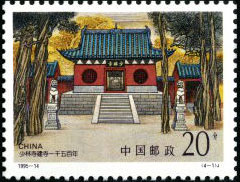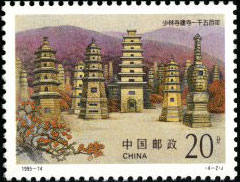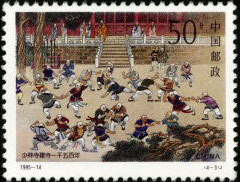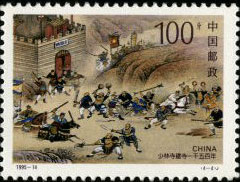1995-14, Scott 2589-92 The 1500th Anniversary of the Shaolin Temple
Technical details
Scott No: 2589-92Serial number: 1995-14
Values in set: 4
Date of issue: August 30, 1995
Designers: Li Defu; Yang Wenqing
Size: 40*30mm
Perforation: 12
Sheet composition: 50
Printing process: offset
Background
The Shaolin Temple in Mt.Songshan is the source of the Zen sect of Buddhism and birthplace of the Shaolin martial arts. When an eminent monk came from India to do Missionary work in China during the Northern Wei Dynasty (386-534), a temple was built for him by Xiaowen Empeor in the wood at the northern side of the Shaoshi Mountain, hence the name of the Shaolin Temple. Later the Indian eminent monk Bodhidharma came and founded the Zen sect of Buddhism in the Shaolin Temple. In history, Bodhidharma is regarded as the founder of the Zen sect of Buddhism and the Shaolin Temple as the place where the founder lives. The Zen sect of Buddhism advocates the epitomization of all the moral teachings of Buddhism with deep meditation. After the Tang Dynasty (618-907), Zen gradually developed into a major school of Buddhism. The thoughts of Zen had an important impact on the ancient culture of China. According to historical materials, in early Tang Dynasty, the monks of the Shaolin Temple made important contribution to the first emperor of the Tang Dynasty, Tai Zong, in founding the dynasty and had approved by the emperor to practice boxing. The Shaolin martial arts have enjoyed a great reputation for long and have been widely spread.The existing architectures of the Shaolin Temple include the main gate, abbot's room, Bodhidharma Pavilion, the Hall of White Cloth and the Hall of Countless Buddha Statues. In the Hall of Countless Buddha Statues, there is the more than 300-meter-long wall painting of the Five Hundred Arhats Paying Religious Homage to Vairocana dated back to the Ming Dynasty (1368-1644). Precious cultural relics also include the wall paintings of the Qing Dynasty (1644-1911) preserved in the Hall of white Cloth on the record of the Shaolin boxing and the 13 Shaolin monks helping Li Shimin (the first emperor of the Tang Dynasty) break out of an encirclement. The Tower Forest in the west of the temple is the cemetery of monks for generations and is composed of more than 220 brick-stone towers of different forms that were built between Tang and Qing dynasties. It is a treasure-house for the comprehensive study of the art of brick-stone architecture and sculpture in ancient China. Also well preserved in the temple are more than 300 steles since the Tang Dynasty.
Today the old Shaolin Temple has become a famous spot of Buddhism and a tourist attraction.
Price List
Item location: China
Ships to: Worldwide
*Shipping (via registered air mail) is based on subtotal of order. See detials below.
* 1) for special items shipping and handling cost may be included. 2) Other fast shipping is available.
To special order, please let us know what you are looking for. We will help you to meet your unique interests.
Ships to: Worldwide
*Shipping (via registered air mail) is based on subtotal of order. See detials below.
| Order Subtotal | S & H |
| $0.01---$15.00 | US $5.00 |
| $15.01---$50.00 | US $6.00 |
| $50.01---$100.00 | US $7.00 |
| $100.01---$180.00 | US $8.00 |
| $180.01---over | US $9.00 |
To special order, please let us know what you are looking for. We will help you to meet your unique interests.

 (4-1), Gate of Shaolin Temple, 20 fen, 40*30mm
(4-1), Gate of Shaolin Temple, 20 fen, 40*30mm







